Ten years ago, I rushed into the crypto world with 30,000 yuan.
At that time, I was just like you—full of dreams of getting rich overnight.
Ten years later, my assets exceeded ten million.
In the crypto world, if you want to achieve true financial freedom and compound interest, methods, techniques, and forming your own profit system are crucial!
Once you learn to master it, the crypto world will be like your 'ATM', making money as easy as breathing!
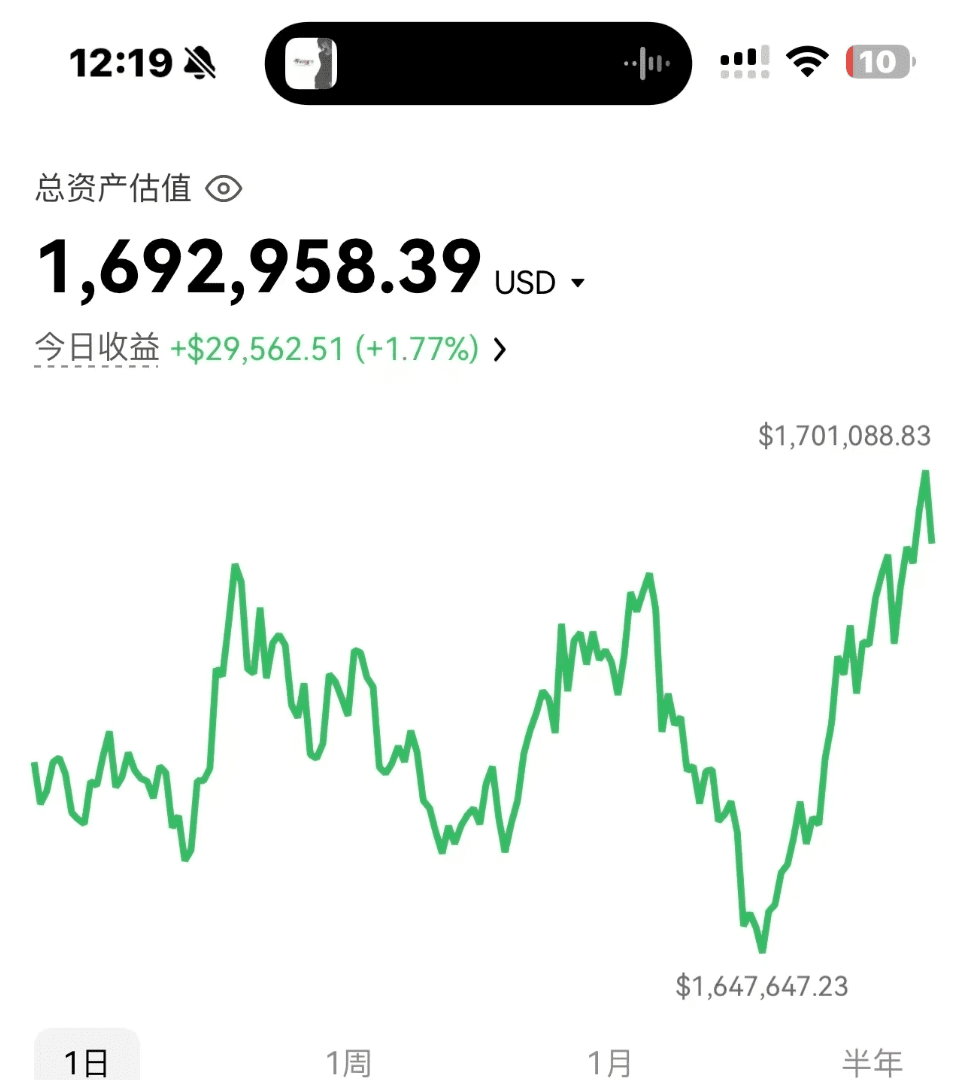
After more than 10 years in crypto trading, my wealth journey can be summarized as follows:
The first ten million took the longest and was the most painful. The trading system continued to reshape and refine, taking a year and a half.
The second 10 million took three months.
The third ten million took only 40 days.
The fourth ten million took only 5 days.
75% of the funds are made within half a year.
But along the way, watching countless people blow up their accounts, clean out their bags, and lose everything, I realized:
The truth in the crypto world is never about who makes money quickly, but who dies slowly.
Today, I won't talk about motivational quotes; I will only share the essentials—understanding these points can at least save you five years of tuition.
1. Want to make money? Don't die first!
✅ 1. Risk control is not a skill; it's a talisman!
• The most common way for beginners to lose: going all-in, chasing coins, and losing everything in three days.
• My bottom line rule:
• Funds divided into five parts, using only one part each time.
• If a single loss exceeds 10%, close the position immediately.
• Monthly loss exceeds 20%, turn off the computer immediately.
• Don't fantasize about 'breaking even'; surviving is the first hurdle.
✅ 2. In the face of trends, don't pretend to be a hero.
• You can hold a big bull position, not because you are smart, but because you know the situation.
• Key signals:
• 30-day line + 120-day line moving upwards together = bull market eating meat.
• Diverging moving averages on the downside = bear market traps.
📌 Remember: The market is a big river; you need to float with the current, not paddle against it.
✅ 3. Less is more; the more refined the indicator, the more ruthless.
I am now only focusing on two signals:
• MACD golden cross + volume increase = entry signal.
• Volume increase on the rise = bait, volume increase on the fall = real collapse.
Trading coins is not about who uses more indicators, but who reacts quickly and decisively.
2. Three major pitfalls in the crypto world, 99% of beginners fall into them.
🚫 1. Long-term faith will ruin you without discussion.
• Besides BTC/ETH, holding other coins for three years = chronic liquidation.
• I personally experienced: in 2018, stubbornly holding a certain altcoin, going from 10 dollars to 0.1 dollars.
• My current allocation:
• BTC/ETH pressure support.
• Clear out altcoins at the target point, never engage in protracted battles.
🚫 2. Leverage is a devil, not an ATM.
• Yes, 10x leverage doubling is exhilarating.
• But I have also seen real stories of 30 million turning to 0 in a day.
💥 Recommendation:
• Newbies should avoid leverage for two years.
• Experienced traders should open a maximum of 5x leverage, keeping positions under 30%, and no stop loss = seeking death!
🚫 3. Hot spots ≠ opportunities; they are the graveyards for retail investors.
• When AI coins and Meme coins surge, the main players are offloading in batches, and retail investors rush in to catch the falling knives.
• I only trade these two coins:
• Bottom consolidation for more than 3 months.
• Breakout with volume + on-chain anomaly data support.
Missing opportunities is not scary; stepping on a mine is deadly.
3. Short-term vs. Long-term, the key depends on the market stage.
Bull market = eating waves.
• Position structure: BTC/ETH + leading tracks (like Layer2)
• Don't be scared away by pullbacks as long as the moving averages are not broken.
Bear market = quick in and out.
• Only focus on short-term opportunities, monitor 15min/1h charts.
• Make 3-5% profit per trade and exit; risk aversion is king.
⚠️ Always keep 30% cash flow—this is your confidence to survive and the spark for your next turnaround.
Final advice:
The crypto world can indeed turn around, but it only rewards those who are patient and disciplined.
In the past ten years, I have lost money, blown accounts, and almost exited the market.
To get to today, it's not because I am talented, but because I always remember one thing:
Do simple things to the extreme, and luck will naturally come.
If you are still losing money, you might as well stop trading and read this article a few times.
Trust me, the market will not reward those who are anxious.
Money in the crypto world is never made by 'trading'; it is made by 'enduring'.
If you really want to survive in the crypto world and even achieve stable profits, you can take the following words to heart.
❶ No take profit and stop loss, don't say you are trading.
Setting stop losses is to control greed.
Setting a stop loss is to avoid catastrophic losses.
The market fluctuates; you can be wrong once, but you can't hold on stubbornly.
You are not a god; guessing wrong is normal. Recognizing mistakes and taking losses is a basic quality of a mature trader.
❷ The more you do, the more you get wrong.
Don't always fantasize about 'making money on both sides'—
The market doesn't feed you; it only rewards those who 'wait for opportunities'.
Frequent trading will only lead you to exit early amidst transaction fees and emotional fluctuations.
The truly profitable trades are not many but must be stable.
❸ Holding a short position is a skill.
Are you brave enough to hold a short position? Most people aren't. Because 'being empty' means 'not making money'.
But the fact is—forcing entry when the market is unclear is gambling.
Learn to wait, then you qualify to seize the next wave of certainty.
❹ Don't treat contracts as a shortcut to recovery.
Using 100 dollars to open a 10x position, gaining 20 on a two-point rise seems easy.
But similarly, a drop of two points brings it directly back to the starting point.
When you want to get rich overnight, you are already moving further away from rationality.
Making money relies on discipline, execution power, and patience, not fantasy.
❺ Going all-in is a romantic notion for retail investors.
Many people blow up their accounts, not because the market is wrong, but because their position is wrong.
Even if the trend is right, without setting a stop loss, heavy positions will still suffer significant losses.
Light positions + risk control are the fundamentals for lasting survival and long journeys.
❻ The biggest difficulty is not the technique, but human nature.
It's not that you don't understand, but that you can't do it;
It's not that you can't take profit and stop loss; it's that you're lucky in your heart.
It's not that you can't control your positions, but you want to turn things around too quickly.
So ask yourself: what you can't do is it technique or self-discipline?
Ultimately, contracts don't require you to be exceptionally smart; they just need you to do these six points and continuously execute them mechanically. It's difficult, but because it's difficult, only a few can make money.
In the crypto world, making 1 million requires either a bull market and holding on, or betting on a rich coin, or high leverage to bet in the right direction. But most people are losing money, so don't just look at the stories of getting rich; first, think about how much risk you can bear.
If you are also a technical enthusiast in the crypto world, click on the homepage.
Click on my avatar to follow me for first-hand information and in-depth analysis!
I personally tested this method and turned 500,000 into 10 million in results, using only this trick (Wolfe Wave trading strategy), with a win rate of up to 99%, suitable for everyone!
Recall when I first entered the trading market; I tried everything to find knowledge about this online, hoping to learn everything as soon as possible so I could start practical trading and make money.
Here comes the good stuff!
You can achieve large segments without indicators! The most comprehensive Wolfe Wave trading strategy tutorial on the internet: drawing methods, rules, entry and exit, stop loss and take profit are all included.

Regarding the Wolfe Wave pattern (Wolfe Wave), I have mentioned it multiple times in previous articles. It is a powerful chart pattern that often appears near the endpoints of price trends. Therefore, it is considered a counter-trend trading strategy. The Wolfe Wave pattern has proven to be a reliable trading signal worth studying and understanding by technical analysts. This article will focus on the most important features of the Wolfe Wave pattern and some best practices for applying it in the market.
Understanding the Wolfe Wave.
Wolfe Waves are a unique pattern that appears in price sequences. A standard Wolfe Wave structure consists of five segments, and these segments exhibit very symmetrical shapes in bullish or bearish contexts. This pattern most commonly appears within an upward or downward trend channel.
Although this pattern can also occur in fluctuating market conditions, the most ideal Wolfe Wave pattern typically shows a degree of trend in price movements. Technical traders can use this pattern to grasp entry opportunities more effectively. To correctly identify this structure, specific Wolfe Wave rules must be met.
The concept of the Wolfe Wave was studied and introduced to the technical analysis trading community by Bill Wolfe. The Wolfe Wave pattern can occur in all time frames of freely traded and liquid financial markets.
Therefore, the Wolfe Wave pattern is considered to have fractal characteristics and can appear on very small time scales such as one-minute or five-minute charts, as well as larger time scales such as weekly or monthly charts.
When traders can correctly identify a Wolfe Wave pattern, they can execute buy or sell setups at high probability reversal points and can accurately determine the target points of that trade. Therefore, the Wolfe Wave pattern can be an excellent addition to any technical analysis trader's toolkit. Next, we will take a closer look at what the Wolfe Wave pattern looks like.
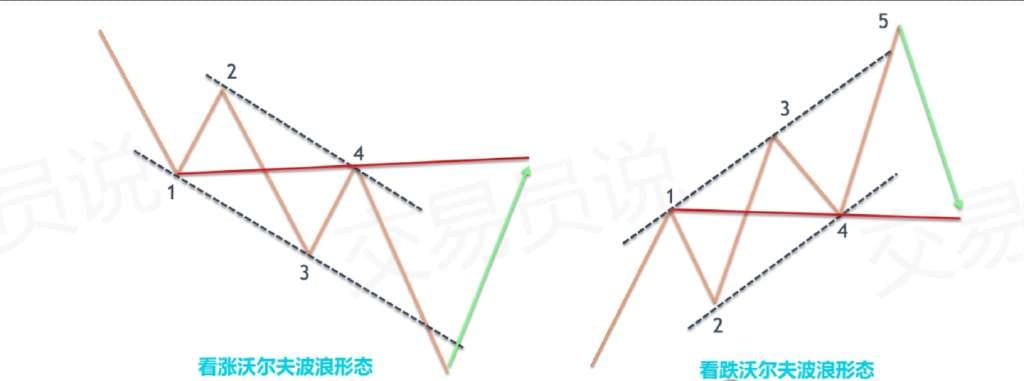
In the picture above, the left side shows a bullish (bullish) Wolfe Wave pattern, while the right side shows a bearish (bearish) Wolfe Wave pattern.
⊙ A buy signal occurs near the endpoint of the fifth wave of the bullish Wolfe Wave pattern, at which point the 1-3 trend line has already been broken downward. After that, the price is expected to rise and encounter resistance near the 1-4 trend line.
⊙ A sell signal occurs near the endpoint of the fifth wave in the bearish Wolfe Wave pattern, at which point the 1-3 trend line has been broken upward. Subsequently, the price is expected to decline and find support near the 1-4 trend line.
Bullish Wolfe Wave pattern.
Wolfe Waves usually form in parallel or equidistant channels. In other words, the Wolfe Wave pattern will appear between two relatively parallel trend lines. In the structure of the bearish Wolfe Wave pattern, there will be five price segments, these segments have roughly equal lengths and show symmetry.
In the image below, you can see an example of a bullish Wolfe Wave pattern.
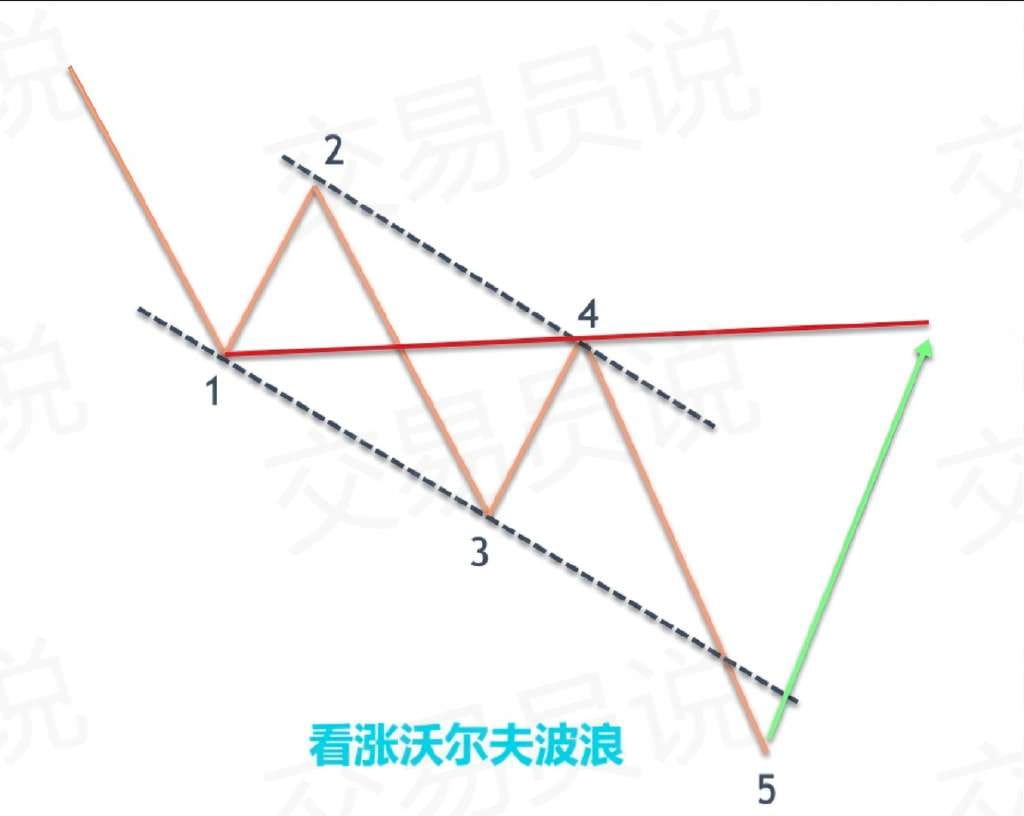
The bullish Wolfe Wave structure starts to decline from the first wave. At some point, the first wave will form a swing low, after which the price begins to rebound upward in the second wave. After the second wave ends, the third wave starts to decline again, eventually falling below the starting point of the first wave. Then comes the fourth wave upward, but its peak is lower than the high of the second wave.
At this point, we need to draw a trend line connecting the endpoints of the first wave and the third wave, called the 1-3 trend line. At the same time, draw another trend line connecting the endpoints of the second wave and the fourth wave, called the 2-4 trend line. We want to see the 1-3 trend line and the 2-4 trend line approximately parallel.
Finally, the fifth wave should extend downward, breaking below the swing low of the third wave and falling below the lower boundary of the 1-3 trendline.
When the price breaks below the 1-3 trend line, if it finds support in that area and returns to the channel, it will trigger a buy signal. Once the price re-enters the channel, we can confidently mark that structure as a valid bullish Wolfe Wave.
The bullish Wolfe Wave pattern is a counter-trend trading strategy. We hope to go long in the overall downtrend to capture an upcoming upward reversal. The bullish Wolfe Wave structure will provide a target point calculated through the 1-4 trend line. When the price approaches this level, it is expected to encounter resistance, making it a good opportunity for us to close long positions.
Bearish Wolfe Wave pattern.
Similar to the bullish Wolfe Wave variant, the bearish Wolfe Wave pattern will also appear in a parallel channel, where the rising 1-3 trend line is relatively close in angle to the rising 2-4 trend line. The bearish Wolfe Wave pattern also consists of five price segments, which have relatively close lengths and exhibit a degree of symmetry.
Now let's delve into the details of the bearish Wolfe Wave structure. The illustration below shows the bearish Wolfe Wave pattern again.
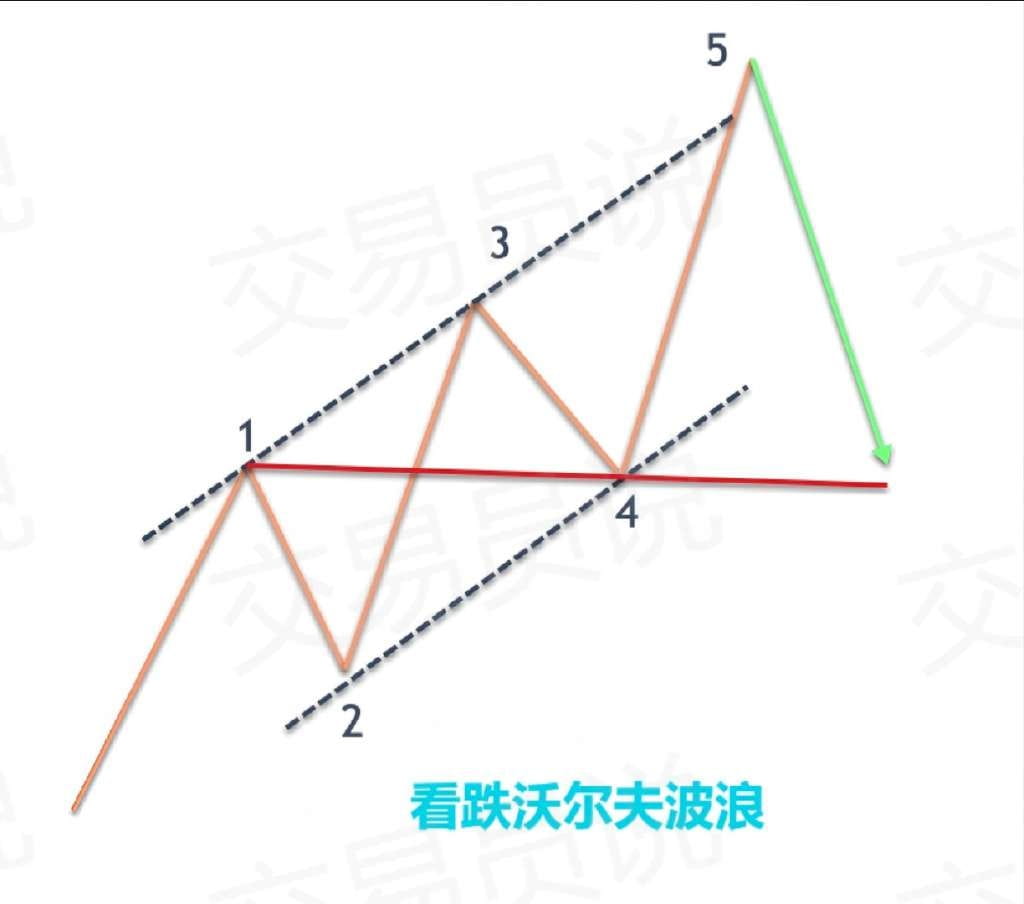
The bearish Wolfe Wave pattern starts from the rise of the first wave. Then, the second wave appears and falls, forming a swing low above the starting point of the first wave. Next, the third wave starts to rise, and its endpoint is higher than the endpoint of the first wave. Then comes the fourth wave, which is opposite to the third wave, pulls back downward, and its endpoint is above the swing low of the second wave.
At this stage, it is necessary to draw a trend line connecting the endpoints of the first wave and the third wave. Another trend line should be drawn connecting the endpoints of the second wave and the fourth wave. These two trend lines should appear roughly parallel. The last wave, the fifth wave, should slightly break above the trend line (especially the 1-3 trend line). This is usually seen as a false breakout.
The real sell entry signal appears when the price breaks above the trend line and then returns to the channel. The price is rejected in that upper area and returns to the channel, confirming the validity of the Wolfe Wave pattern.
As you may have noticed, the bearish Wolfe Wave pattern is a counter-trend trading strategy aimed at shorting in a high probability reversal point in an uptrend. After entering the bearish Wolfe Wave pattern, the expected target price can also be calculated.
To calculate this expected price movement, we need to draw a trend line connecting the endpoints of the first and fourth waves and project it forward. When the price movement approaches this 1-4 trend line, we can expect the price to find support there again.
Wolfe Wave trading strategy
Now let's build a complete trading strategy based on the Wolfe Wave pattern. This will be a purely price action-based strategy, meaning we won't use any other technical indicators or oscillators, but instead focus on the price structure that forms the Wolfe Wave pattern.
Bullish trading entry rules.
⊙ We need to confirm that the price is in a downtrend.
⊙ Once a potential bullish Wolfe Wave pattern is identified, each segment of that pattern needs to be marked.
⊙ Draw a line connecting wave 1 and wave 3, and another line connecting wave 2 and wave 4. These two lines should form a relatively parallel price channel.
⊙ Wave 5 should break through the 1-3 trend line but then quickly reverse and return to this parallel channel.
⊙ When the price appears to close bullish within the channel, it triggers a buy entry signal.
⊙ Stop loss should be set below the swing low of wave 5.
⊙ Draw a trend line connecting wave 1 and wave 4 and project it forward, which will serve as the target level. When the future price touches that target line, close the position.
Bearish trading entry rules.
⊙ We need to confirm that the price is in an upward trend.
⊙ Once a potential bearish Wolfe Wave pattern is identified, each segment of that pattern needs to be marked.
⊙ Draw a line connecting wave 1 and wave 3, and another line connecting wave 2 and wave 4. These two lines should form a relatively parallel price channel.
⊙ Wave 5 should break through the 1-3 trend line but quickly reverse and return to this parallel channel.
⊙ When the price appears to close bearish within the channel, it triggers a sell entry signal.
⊙ Stop loss should be set above the swing high of wave 5.
⊙ A trend line connecting wave 1 and wave 4 projected forward will serve as the target level. When the future price touches that target line, close the position.
Example of a bullish Wolfe Wave strategy.
Next, let's look at a price chart to illustrate the Wolfe Wave trading system outlined in the previous section. In the price chart below, you will see a bullish Wolfe Wave setup in the USD/CAD currency pair on a 240-minute time frame.
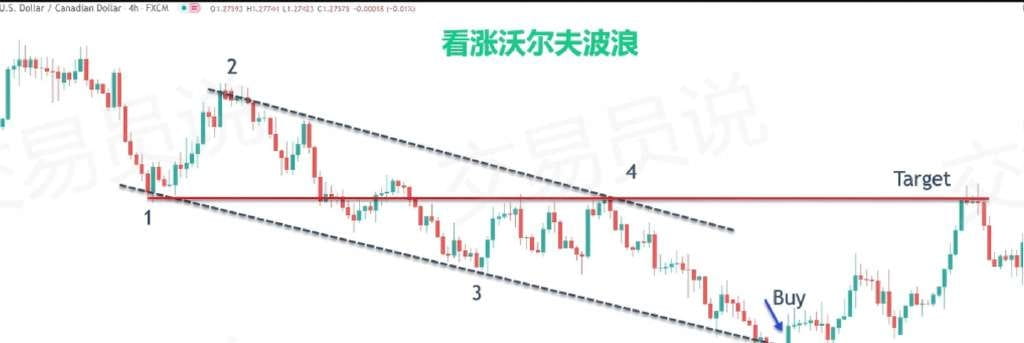
Now let's gradually analyze this potential bullish Wolfe Wave pattern and see how to trade it according to the rules we set earlier. The first and most important point is to ensure that the price of USDCAD is in a downtrend. From the price chart, this is obvious. As the downtrend progresses, we will identify a potential bullish Wolfe Wave pattern forming at some stage.
We will number every segment in the structure starting from the first wave. When the trend enters the early stages of the fifth wave, we can draw two trend lines.
The first line is the 1-3 trend line, which connects the swing lows of the first and third waves.
In addition, we will draw a second trend line connecting the swing highs of the second and fourth waves. After completing this step, we will review both trend lines to confirm that they are roughly parallel.
In the later stages of the fifth wave, we can see that the price breaks below the 1-3 trend line but quickly encounters resistance and rebounds, returning to the price channel. Note the first green candlestick that closed inside the channel—this is our entry signal for going long on the USDCAD currency pair.
Once the buy order is executed and a bullish position is established, we will immediately set a stop loss to prevent any adverse price movements. The stop loss will be set below the swing low of the fifth wave, marked in the chart as the orange line labeled 'Stop'.
Next, we need to mark the potential closing points for this trade. Remember, to do this, we will draw a trend line connecting the endpoints of the first and fourth waves and project it forward. This is illustrated with a deep red line in the price chart.
Notice how the price enters this target area, slightly breaks upward before encountering resistance and retracting. Fortunately, we will close the position at an ideal time, gaining considerable profit.
Example of a bearish Wolfe Wave strategy.
Now let's look at the second Wolfe Wave strategy example. This time, we will focus on a bearish Wolfe Wave structure. Below is the price chart of the USDJPY currency pair on a 240-minute time frame.
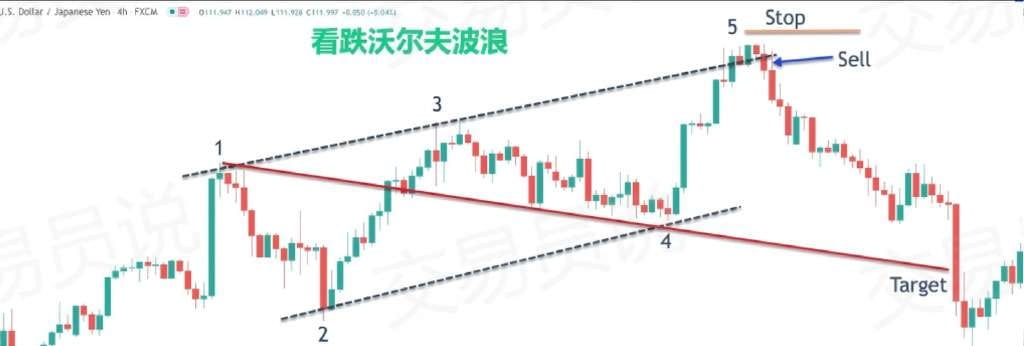
Starting from the far left of the price chart, we can see the price movement rising, thus meeting the initial conditions of the bearish Wolfe Wave strategy. As the price continues to rise, we can see a 'stair-step' price movement, forming waves 1 to 5.
More specifically, we can see that the first and third waves rise along the overall trend, while the second and fourth waves are counter-trend corrections, retracting part of the first and third waves, respectively. As the price continues to rise in the early stages of the fifth wave, we can identify that a potential bearish Wolfe pattern is developing.
Next, we will draw a trend line connecting the swing lows of the second and fourth waves to form the lower boundary of the parallel channel. At the same time, we will also draw another trend line connecting the swing highs of the first and third waves to form the upper boundary of the parallel channel.
In this step, we will wait to see if the price of the fifth wave will break the 1-3 trend line, thus providing us with a potential short opportunity. As shown in the chart, the fifth wave indeed broke the 1-3 trend line and began to consolidate in that area. However, the price was quickly rejected downward, confirming the establishment of the bearish Wolfe Wave pattern.
Then, when the price first returns to the parallel price channel downwards, we will short the USDJPY currency pair using a market order. The position marked as 'Sell' with a blue arrow in the chart indicates this position. Once our sell order is triggered in the market, we need to pay attention to setting the stop loss.
According to our rules, the stop-loss order should be set above the swing high of the fifth wave. The closing target of the trade is estimated through the 1-4 trend line. We will connect the swing high of the first wave with the swing low of the fourth wave and project this trend line forward. Please note how the price enters this target area before reversing upward.
Summary
The Wolfe Wave structure is a lesser-known chart pattern, but if used correctly, it is a very powerful one. The Wolfe Wave pattern appears in many different markets, including stock markets, futures, and forex. It can also be observed across various time frames.
That being said, the most ideal and reliable trading opportunities for the Wolfe Wave pattern usually occur in time frames of four hours and above. Technical analysts should focus on these cycles when looking for high-probability Wolfe Wave patterns. Traders can either manually search for these patterns on price charts or use the Wolfe Wave indicator to assist in identification.
It is worth mentioning that this pattern is often confused with Elliott Wave impulse structures. Although there are some similarities between the Wolfe Wave structure and Elliott Wave impulse structures, there are also very clear differences. While this article does not compare and analyze the differences in detail, this is a topic that serious chart technical analysts should study further.
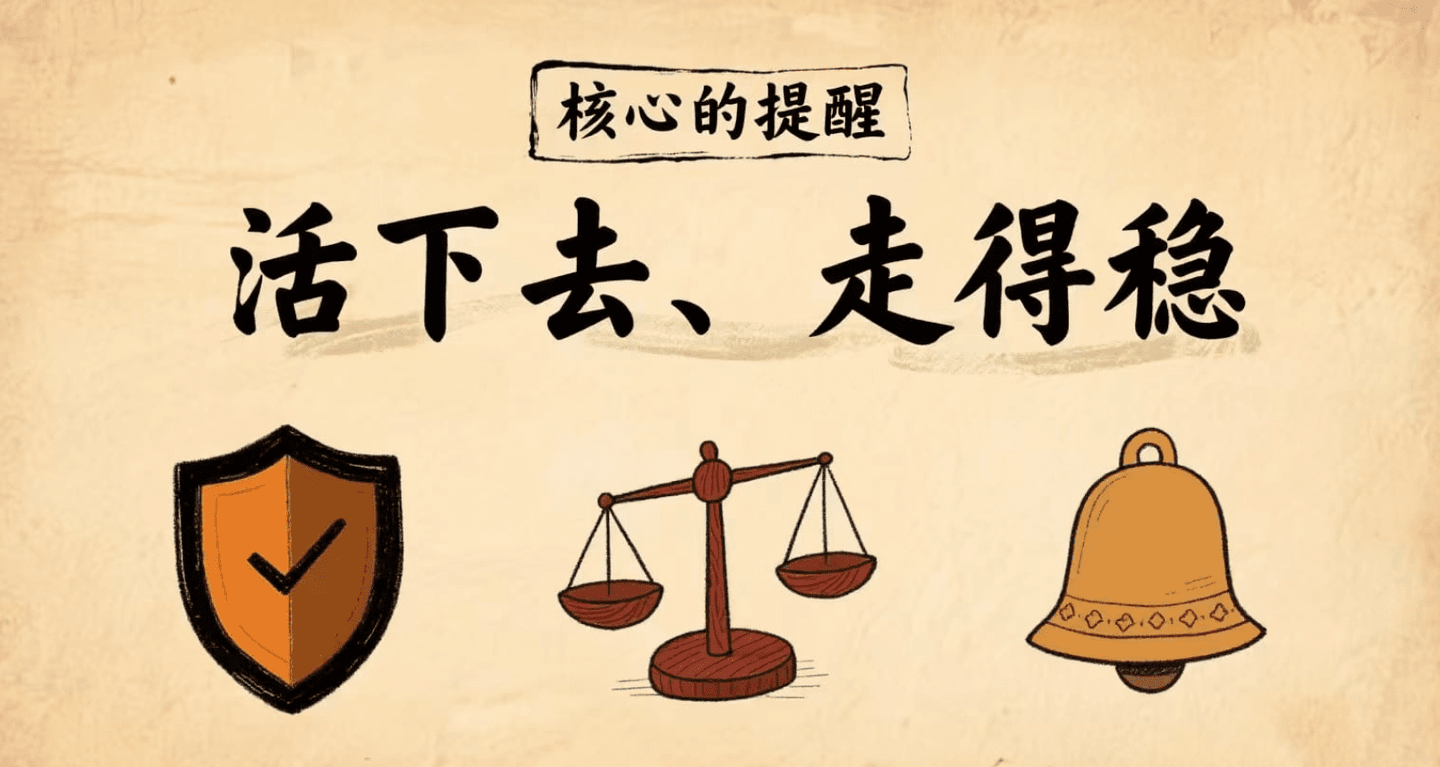
I relied on this trick to turn 800U into 70,000U! Not looking at candlesticks, not monitoring the market, not bottom-fishing—yet I can withdraw every month!
This article is dedicated to those who are suffering from losses, eager to turn things around, and lack direction.
After mixing in the crypto world for 7-8 years, to be honest, the ones who truly make money are never the ones with good technology but the ones who follow the rules, have the right rhythm, and maintain emotional stability.
Your account may now be left with 3000U, 1000U, or even less than 500U. Don't worry; I've seen too many people on the brink of liquidation. The last trick to turn things around—I don’t teach miraculous techniques but survival rules.
[I only rely on one method: the dull explosion method]
The core logic of the dull trading method:
Only trade strong logic and strong trend coins (BTC, ETH, SOL, BNB…)
Only take one trade at a time; if it blows up, come again, but not mindlessly go all-in, but use a spiraling position management method in conjunction with position control.
Not looking at candlesticks, not studying RSI, MACD, FIB, only looking at 'trend direction + large order sentiment'.
Do you believe it? I haven’t looked at a single candlestick for half a year, yet I helped 27 beginners triple their accounts!
Practical case:
Account starting amount: 800U
First time: ETH long, 3x leverage, gained 42 points, profit 412U.
Second time: SOL long, 5x leverage, held for 3 days, +2150U.
Third time: BTC short, all-in 20x leverage, made a huge profit of 16,000U.
[Why do you always lose money trading coins?]
I summarize three typical ways retail investors die.
Chasing hot spots, chasing highs, listening to calls, blowing up accounts and still looking for reasons.
Watching the market every day, emotional ups and downs, doubting life after a loss.
Unclear direction, position control relies solely on feeling, stop loss and take profit have no concept.
To be honest, it's not that you don't work hard; it's that you are going in the wrong direction, and the methods are wrong. No matter how hard you try, it's a dead loop.
Warning: This method is not suitable for everyone.
Suitable for:
Truly wanting to turn around, having patience, and not fantasizing about getting rich overnight.
Can execute, has execution power, not soft-hearted, not procrastinating.
Be willing to hold, trust me, and don't mess with the account.
Not suitable for:
Want to rely on luck, fantasize about getting rich, chase highs and cut lows, impulsively?
Only want to snipe without taking action.
In today's market, a bunch of people are blowing up their accounts, a bunch are being cut, and a bunch are losing tens of millions without knowing where they went wrong.
In the crypto world, making 1 million requires either a bull market and holding on, or betting on a rich coin, or high leverage to bet in the right direction. But most people are losing money, so don't just look at the stories of getting rich; first, think about how much risk you can bear.
If you are also a technical enthusiast in the crypto world, click on the homepage.
Click on my avatar to follow me for first-hand information and in-depth analysis.
